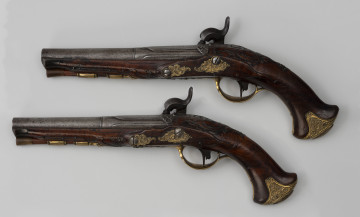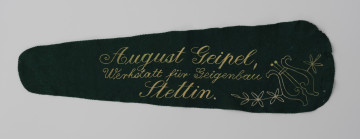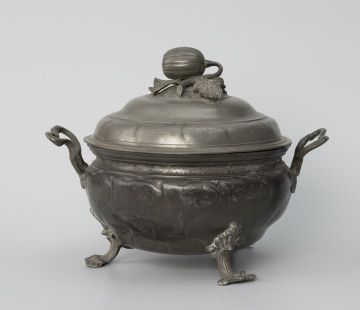
Pair of percussion cap pistols
circa 1773 — 1811
National Museum in Szczecin
Part of the collection: Craft and industry products of Szczecin
Tinsmithery was a craft that dealt with the production of vessels and other functional objects from tin. The material was durable and aesthetically pleasing, and was used in the production of decorative items for churches, castles and the homes of the wealthy bourgeoisie. In Pomerania, one of the most active tinsmith guilds was located in Szczecin, which had more than a hundred professional tinsmiths between the 15th and mid-19th centuries. Johann David Kayser ran his foundry trade from the second half of the 18th to the beginning of the 19th century, and his widow managed his business after his death. From among several of his works currently in the collection of the National Museum in Szczecin, the featured lavabo is one of the more impressive and richly decorated objects. The lavabo took a variety of forms, from simple receptacles and vessel sets to more complex fountains, built-in units, or separate rooms. They were primarily used in the sacristies of churches or outside monastic refectories. Priests used them for washing their hands during the preparation of the offerings at Mass or other services. Lavabos were often decorated with original ornaments, depending on their purpose and the prosperity of the person who ordered them. Stone, ceramics and various metals such as brass and sometimes glass were used for their production. Scaled-down tin pieces were more common in residential interiors. Anna Lew-Machniak
Author / creator
Object type
vessel (container)
Technique
casting, forging, grawerowanie, punching
Material
tin
Origin / acquisition method
purchase
Creation time / dating
Creation / finding place
Owner
Muzeum Narodowe w Szczecinie
Identification number
Location / status

circa 1773 — 1811
National Museum in Szczecin

około 1900
National Museum in Szczecin

około 1770 — 1780
National Museum in Szczecin
DISCOVER this TOPIC
National Museum in Szczecin
DISCOVER this PATH
Educational path